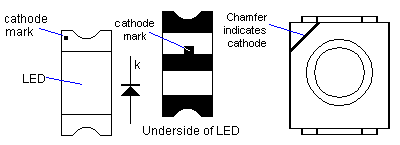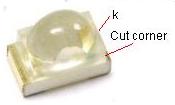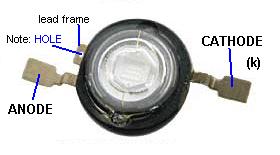The CATHODE lead is
always the lead to be identified with ALL LEDs, including
surface-mount LEDs.
The cathode of a surface
mount LED is very difficult to locate as the device is very small.
There are 3 different identification-marks:
1. A "chamfer" or "cut corner" at one end of
the chip
2. A dot on the top left-corner of the device.
3. A mark in the centre of the underside of the chip as shown in the following diagram:


The cathode of LEDs in the following shape can be
identified by firstly looking for a small protrusion called a "Lead
Frame."
It has a hole in it. The lead near it is the ANODE. The opposite lead is the CATHODE.

A "normal" LED (3mm or 5mm) has a small "flat"
on the skirt of the LED. This indicates the cathode (k) lead.
The cathode lead is the shorter lead.
If both leads have been cut to the same length, and the "flat"
is difficult to locate, the LED can be tested by connecting to
a battery (6v - 9v) and including a 470R resistor in series.
The LED will illuminate when placed as shown in the diagram. It
will not illuminate when around the other way and it will not
get damaged during the test.

Every LED has a different characteristic voltage drop.
The value depends on the color of the LED, the manufacturer, the
batch-number and the
type (such as HIGH-Bright, Super-High-Bright etc).
The voltage also changes very slightly according to the current.
When using the LED Resistor Calculator below, the
following characteristic voltages can be used:
Red LED = 1.7v
Orange LED = 2.1v
Yellow LED = 2.1v
Green LED = 2.3v
High Bright Red = 2v
White LED = 3.4v
Super Bright LED - white (6cd) = 3.4v to 4v
Super Bright LED - blue
(3cd) = 3.5v to 4v
Super Bright LED - red (8cd) = 2.2v to 2.6v
Super Bright LED -
yellow (8cd) = 2.2v to 2.5v
High Intensity Blue = 4.5v
InfraRED Laser (27mW) = 1.2v to 1.6v
Flashing LED (no dropper resistor needed if connected to a supply:
3v - 12v)
(cd = candela 6cd = 6,000mcd)
If you are not sure about a characteristic voltage for a particular
LED, use the values above, fit the LED to a circuit and measure the
voltage across it.
You can then re-calculate the resistor-value.
Always use 20mA for the allowable current in the calculator below,
unless you are informed otherwise. All LEDs will operate for their
full operating life (100,000 hrs) @ 20mA. |
|



